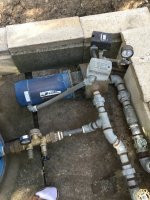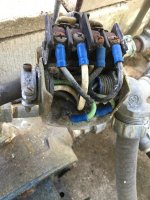Thank you ... and no we haven’t discussed some of your questions yet. To explain, I have a submersible pump in my water well that supplies water about 200 feet horizontal and a climb of approximately 40+ feet to a 2500 gallon holding tank. That tank is full all the time and is monitored by a float valve in the tank. I assume that when the float valve closes, which stops the water from entering into the top of tank from actual well, the back pressure is detected and the submersible pump hits psi limit and shuts the submersible pump off. That 2500 gal. tank then supplies water to the pressure pump installation via gravity which then uses the above ground pump and pressure tank to maintain water pressure in the house between 40/60 psi. This second pump installation is what I have photographed with the two pressure switches. Based on what you shared, I suspect that reverse low pressure switch is installed in line BEFORE the 40/60 pressure switch as a safety so that if the water tank runs dry for some reason this second pump won’t continue to pump or short cycle and burn out. Does that sound logical? Sorry, what did you mean by the expression ‘deadheads’. When I bought this property I was looking for a low water alarm that might alert me to a falling water level in the water tank to address before all the water is gone from tank, but there is none and possibly that is not a common component of a well system. I’m a building contractor but had no well experience until I purchased this property. Thank you for your assistance it is appreciated ... Aaron


